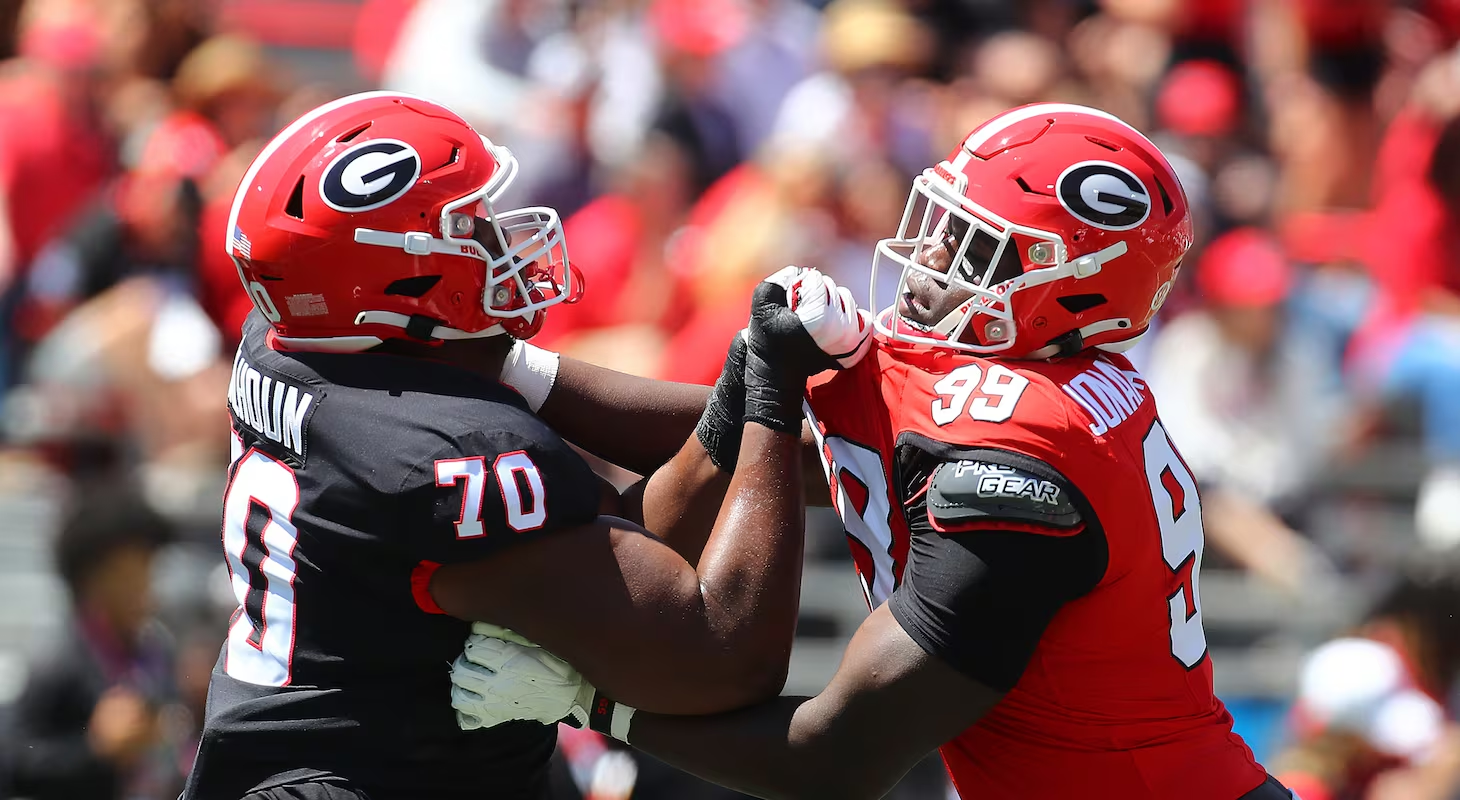The Georgia Bulldogs are concentrating on training young offensive lineman due to a major injury.
The Georgia Bulldogs have long been recognized as a powerhouse in college football, with their commitment to excellence in every position group. However, like any successful program, they occasionally face adversity, and one of their current challenges revolves around a major injury on the offensive line. This injury has forced the Bulldogs to place an even greater emphasis on developing their younger offensive linemen, a move that is both necessary and potentially transformative for the program’s future.
The Importance of the Offensive Line
Before delving into the specifics of how Georgia is adjusting to this injury, it’s important to understand the crucial role that the offensive line plays in a football team’s success. The offensive line is often described as the unsung hero of a football team. While the quarterback and running backs often receive the accolades for their success, it is the offensive line that is responsible for creating the foundation upon which the offense operates.
The offensive line’s primary responsibility is to protect the quarterback and create lanes for the running backs. A strong, cohesive offensive line is essential for establishing a balanced and effective offense. Without good blocking, even the most talented skill position players will struggle to make an impact. For a team like Georgia, which prides itself on a balanced, physical style of play, the offensive line is especially important.
The Injury: A Major Setback for Georgia
In any given season, injuries are an unfortunate reality for any football team, and Georgia is no exception. The Bulldogs recently suffered a significant blow to their offensive line with the injury to a key starter. While details of the injury may vary, the impact is clear: this injury has left a noticeable gap in Georgia’s offensive line depth and stability. For a program that is routinely competing for national championships, injuries can have a profound impact, especially when they occur in critical positions like the offensive line.
This injury has forced Georgia to reconsider its offensive line depth chart and focus on developing younger players who may not have seen significant playing time before. Given the injury’s severity, the Bulldogs’ coaching staff has been tasked with rapidly accelerating the development of their younger offensive linemen in hopes of minimizing any drop-off in performance.
The Youth Movement: Training the Next Generation
The injury to a key offensive lineman has created an urgent need for younger players to step up. Georgia has a solid track record of recruiting top-tier talent, and their offensive line is no exception. However, many of these younger players are still in the early stages of their college careers and may not have the same level of experience or cohesion as the veteran players. This has created an interesting dynamic in Georgia’s spring and summer practices as the coaching staff places a significant focus on training and developing these young players.
Recruiting and Development Pipeline: One of the reasons Georgia has been able to weather this injury is the program’s ability to recruit high-level offensive line talent. Head coach Kirby Smart and his staff have built one of the most impressive recruiting pipelines in the country, and Georgia has continually brought in top offensive line recruits from across the nation. Many of these players, while young, come into the program with impressive physical attributes, work ethic, and football IQ.
However, transitioning from high school to college football can be challenging, especially in the trenches. College football is faster, stronger, and more physical than what many high school players are accustomed to, and the offensive line is one of the most difficult positions to adjust to at the collegiate level. Developing these young players is not just about teaching them how to block or understand offensive schemes; it’s about helping them adapt to the speed of the game, improving their strength and conditioning, and building the mental toughness necessary to succeed in such a demanding position.
Coaching Focus on Fundamentals: With the injury to a key starter, Georgia’s coaching staff has placed an increased emphasis on ensuring that the younger offensive linemen master the fundamentals of the position. Offensive line coach Matt Luke, who has been with the program for several seasons, has worked tirelessly to prepare his players, particularly the younger ones, for more significant roles in the offense. Luke’s coaching philosophy emphasizes a combination of technique, strength, and mental sharpness. He focuses on individual fundamentals such as hand placement, footwork, and pad level, which are essential for offensive linemen to execute their responsibilities on the field.
One of the key areas the coaching staff has been working on is teaching these younger players how to properly read and react to different defensive fronts. Offensive line play is often about making quick, split-second decisions, whether it’s identifying blitzes or understanding how to execute a double-team block. With limited experience in game situations, younger players may struggle with these nuances. Therefore, Georgia’s staff has invested a great deal of time in helping their young linemen become more comfortable with reading defenses and adjusting on the fly.
Strength and Conditioning: In addition to the technical aspects of offensive line play, Georgia’s strength and conditioning staff has played a crucial role in developing the younger linemen. The physical demands of playing offensive line are immense, and it takes time for young players to develop the strength and conditioning necessary to compete at a high level. Offensive linemen must have the power to control defenders in the trenches, the endurance to sustain blocks throughout the course of a game, and the agility to move laterally and react quickly.
Georgia’s strength and conditioning program is one of the best in the country, and it has been instrumental in the development of their offensive linemen. Under the direction of head strength coach Scott Sinclair, the Bulldogs’ players undergo rigorous offseason training designed to build both strength and explosiveness. For younger offensive linemen, the program focuses on improving their core strength, foot speed, and overall conditioning. This allows them to compete more effectively in one-on-one situations and maintain their performance throughout the game.
Mental Toughness and Leadership: Aside from physical and technical development, the coaching staff has also emphasized the importance of mental toughness and leadership among the younger offensive linemen. Offensive line play requires a high level of mental discipline, as players need to remain focused and composed under pressure. The younger linemen must learn how to respond to adversity, both on the field and off it, and develop the resilience necessary to succeed in the intense environment of college football.
Moreover, leadership plays a critical role in offensive line play. While individual performance is crucial, offensive line play is about working together as a cohesive unit. With a key player out due to injury, it’s essential that the younger players step up, not just in terms of their physical performance but in terms of leadership as well. Older players on the line, particularly those who have experience but may not be starters, have taken it upon themselves to mentor and guide the younger players. This leadership dynamic has been crucial in ensuring the success of the younger linemen as they adjust to increased responsibilities.
Impact on Georgia’s Offensive Strategy
As Georgia trains its younger offensive linemen, there are significant implications for the team’s overall offensive strategy. With the injury to a key player, the Bulldogs may need to adjust their offensive approach to accommodate the changes on the line. While Georgia has traditionally favored a power-running attack, there may be a greater focus on passing or using quicker, more dynamic offensive schemes to mitigate any potential weaknesses on the offensive line.
Balanced Offense with Flexibility: One possible adjustment is for Georgia to adopt a more balanced approach on offense, mixing up the run and pass to keep defenses off-balance. The Bulldogs have a talented group of running backs, but they will need time to work behind a line that may not yet have the cohesion of previous years. To compensate for any potential shortcomings on the line, Georgia might look to implement a more dynamic passing game to keep defenses honest. Quick passes, screens, and short-yardage plays could become more prominent as the younger offensive linemen gain experience and confidence.
Focus on Depth: Another consideration is the increased focus on depth within the offensive line. Injuries are inevitable, and the Bulldogs’ coaching staff has been working diligently to ensure that all their offensive linemen are ready to contribute at any given moment. This emphasis on depth will be critical, not only in response to the current injury but also in preparing for future seasons. By developing a group of versatile offensive linemen, Georgia will ensure that it has the personnel to succeed, regardless of injuries or other setbacks.
Injuries are an unfortunate part of college football, but they also provide opportunities for growth and development. For the Georgia Bulldogs, the injury to a key offensive lineman has created a pressing need to develop younger players quickly. With a strong recruiting pipeline, excellent coaching, and a commitment to building mental and physical toughness, Georgia is well-positioned to meet this challenge head-on. The younger offensive linemen are gaining valuable experience that will pay dividends both in the short term and in the future, as they develop into the next generation of Bulldog stars. While the injury is certainly a setback, it may ultimately strengthen the team and help position Georgia for continued success in the years to come.



